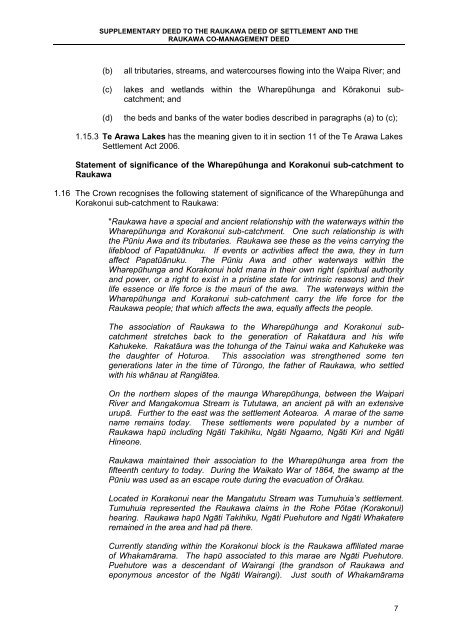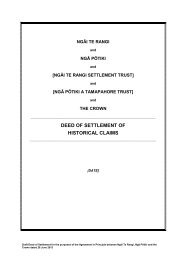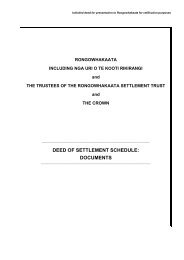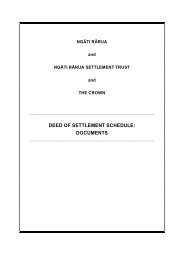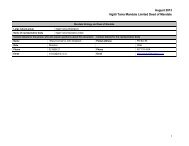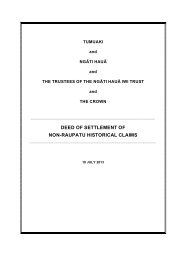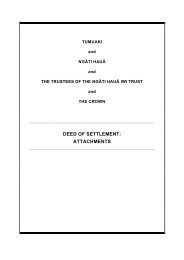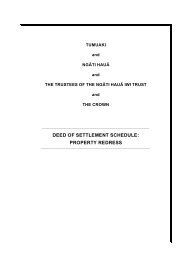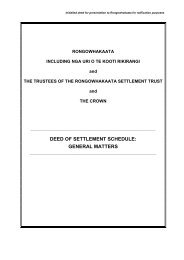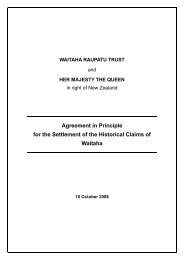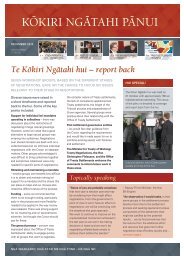SUPPLEMENTARY DEED TO THE RAUKAWA DEED OF ...
SUPPLEMENTARY DEED TO THE RAUKAWA DEED OF ...
SUPPLEMENTARY DEED TO THE RAUKAWA DEED OF ...
Create successful ePaper yourself
Turn your PDF publications into a flip-book with our unique Google optimized e-Paper software.
<strong>SUPPLEMENTARY</strong> <strong>DEED</strong> <strong>TO</strong> <strong>THE</strong> <strong>RAUKAWA</strong> <strong>DEED</strong> <strong>OF</strong> SETTLEMENT AND <strong>THE</strong><br />
<strong>RAUKAWA</strong> CO-MANAGEMENT <strong>DEED</strong><br />
(b)<br />
(c)<br />
(d)<br />
all tributaries, streams, and watercourses flowing into the Waipa River; and<br />
lakes and wetlands within the Wharepūhunga and Kōrakonui subcatchment;<br />
and<br />
the beds and banks of the water bodies described in paragraphs (a) to (c);<br />
1.15.3 Te Arawa Lakes has the meaning given to it in section 11 of the Te Arawa Lakes<br />
Settlement Act 2006.<br />
Statement of significance of the Wharepūhunga and Korakonui sub-catchment to<br />
Raukawa<br />
1.16 The Crown recognises the following statement of significance of the Wharepūhunga and<br />
Korakonui sub-catchment to Raukawa:<br />
"Raukawa have a special and ancient relationship with the waterways within the<br />
Wharepūhunga and Korakonui sub-catchment. One such relationship is with<br />
the Pūniu Awa and its tributaries. Raukawa see these as the veins carrying the<br />
lifeblood of Papatūānuku. If events or activities affect the awa, they in turn<br />
affect Papatūānuku. The Pūniu Awa and other waterways within the<br />
Wharepūhunga and Korakonui hold mana in their own right (spiritual authority<br />
and power, or a right to exist in a pristine state for intrinsic reasons) and their<br />
life essence or life force is the mauri of the awa. The waterways within the<br />
Wharepūhunga and Korakonui sub-catchment carry the life force for the<br />
Raukawa people; that which affects the awa, equally affects the people.<br />
The association of Raukawa to the Wharepūhunga and Korakonui subcatchment<br />
stretches back to the generation of Rakatāura and his wife<br />
Kahukeke. Rakatāura was the tohunga of the Tainui waka and Kahukeke was<br />
the daughter of Hoturoa. This association was strengthened some ten<br />
generations later in the time of Tūrongo, the father of Raukawa, who settled<br />
with his whānau at Rangiātea.<br />
On the northern slopes of the maunga Wharepūhunga, between the Waipari<br />
River and Mangakomua Stream is Tututawa, an ancient pā with an extensive<br />
urupā. Further to the east was the settlement Aotearoa. A marae of the same<br />
name remains today. These settlements were populated by a number of<br />
Raukawa hapū including Ngāti Takihiku, Ngāti Ngaamo, Ngāti Kiri and Ngāti<br />
Hineone.<br />
Raukawa maintained their association to the Wharepūhunga area from the<br />
fifteenth century to today. During the Waikato War of 1864, the swamp at the<br />
Pūniu was used as an escape route during the evacuation of Ōrākau.<br />
Located in Korakonui near the Mangatutu Stream was Tumuhuia’s settlement.<br />
Tumuhuia represented the Raukawa claims in the Rohe Pōtae (Korakonui)<br />
hearing. Raukawa hapū Ngāti Takihiku, Ngāti Puehutore and Ngāti Whakatere<br />
remained in the area and had pā there.<br />
Currently standing within the Korakonui block is the Raukawa affiliated marae<br />
of Whakamārama. The hapū associated to this marae are Ngāti Puehutore.<br />
Puehutore was a descendant of Wairangi (the grandson of Raukawa and<br />
eponymous ancestor of the Ngāti Wairangi). Just south of Whakamārama<br />
7


